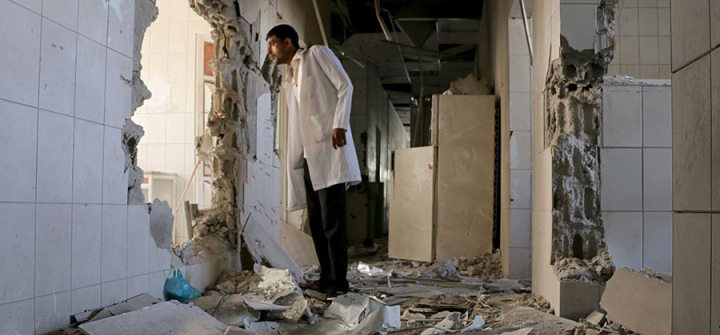Perilous Medicine: The Quest to Restore Protections for Health Workers
When Serbian forces bombed Sarajevo, Bosnia on May, 26, 1992, the pediatric hospital came under direct attack. Nurses scrambled to save 17 premature babies—carrying 2 or 3 apiece to the basement while bullets and shells rained down.
9 of the babies died.
That’s just one of the egregious examples of attacks on health care that Leonard Rubenstein, JD, describes in his new book, Perilous Medicine. In the decades since, such attacks have continued relentlessly around the world. The precise number isn’t known, but in 2019, there were at least 1,200 acts of violence against health care facilities and workers—likely an undercount. The aggressors rarely face any consequences.
Rubenstein, Professor of the Practice at the Johns Hopkins Bloomberg School of Public Health, recounts the history of the protection of health care in conflict and the erosion of those norms. Along the way, he shares stories of health workers and activists he’s met on the frontlines. Rubenstein calls out the global paralysis on the issue, maps out ways to end the impunity, and presses the global health community to make it a priority.
Who did you write this book for, and what do you hope they’ll take away?
I wrote it, first and foremost, for those who take enormous risks to provide care in the midst of war, so that their commitment to health can be matched by a commitment to rights to their protection. At the same time, I wanted to enhance understanding of the pervasiveness of the violence, the logics animating it, and its devastating impacts for millions of people already suffering in war. Another goal was to seek to engage the public health, nursing, and foreign policy communities—and the wider public—in stopping it.
Can you share one of the most memorable health workers featured in your book?
A nurse in Bambari, Central African Republic, comes to mind. When combatants stormed his hospital and demanded that he turn over people targeted for their ethnic or religious backgrounds, he tried to hide a patient behind a mattress. The nurse couldn’t really protect the patient—and he was as vulnerable to the violence as the patient—yet he felt the added pain of not being able to do his medical duty to the patient. He said: “I thought if she died that day, perhaps I would be responsible for her death. Yes, I could provide care but I couldn’t do anything else. I felt powerless.” It is a common experience for health workers at high personal risk of violence—but carrying the additional moral burden of not being able to carry out deeply felt obligations to patients.
What can the global health community learn from this book?
The most important message perhaps is that the goals of the global health community to build effective health systems and enhance people’s life chances can never be achieved as long as violence against health care in armed conflict remains so low a priority on the global health agenda. What we see in so many conflicts is the destruction of those systems, flight of health workers, declines in access to care, and consequent increases in morbidity and mortality.
At the same time, I try to shed light on what is driving the attacks, contemporary challenges to long-existing norms and laws to protect and respect health care in war, and what can be done to prevent attacks and hold perpetrators to account.
How can the nursing, medical, and public health communities advocate more effectively for change?
It begins with solidarity. These communities should speak out on behalf of their colleagues and support them in all possible ways. In Syria, in Yemen, and in so many other conflicts, health workers feel abandoned. They can also use their voices, knowledge, and credibility to pressure their governments to comply with obligations and to end impunity for combatants that grossly violate the rules.
How can states be held responsible for transgressions?
Mechanisms to hold them to account exist—through domestic and international justice institutions, through UN mechanisms to call out perpetrators, and through imposition of diplomatic and other consequences on combatants who breach the rules. They can cease selling arms to perpetrators. The problem is that these steps have rarely been taken. 5 years ago, the problem of violence in health care in conflict was addressed by the UN Security Council, which adopted a very strongly worded resolution and a comprehensive list of actions to prevent attacks and end impunity. Aside from accountability, it called for reform of military practices and of laws that flout long-held global norms by criminalizing health care provided to alleged terrorists. Additionally, the UN secretary-general called for ending arm sales to partners and proxies in wars that used them to commit violations.
Those commitments, however, have gone largely unheeded, and it appears that each flare-up in conflict is accompanied by major assaults on health care—as we have seen this year in Myanmar, Gaza, and Tigray.
Are some countries stepping up and showing leadership?
Health ministries in some countries, including Colombia and Central African Republic, have recognized that this problem falls within their mandate and taken courageous action to speak up, support health workers, and seek to influence the practices of security forces. This is an encouraging development, warranting emulation. As Dr. Pierre Somse, the minister of health of the Central African Republic, has said, addressing violence against health care should be a core function of the field of public health. Legislative bodies can play a role, too. The US Congress recently required the Department of Defense to improve doctrine and training to protect health care in military operations.
Why do so many attacks go undocumented, and what can be done to improve reporting? Constructing a comprehensive system is complicated, though we are making some progress through the work of NGOs and a tracking system on attacks developed by the WHO. The latter, however, needs to be more vigorous and transparent, and we also need more research to understand the drivers of violence and their impact. But we can safely say that today, lack of knowledge of the violence is no longer the problem. It is the failure to act on what we know.
What inspired you to become an advocate on this issue?
In the aftermath of the war in Bosnia in the 1990’s, I read stories of medical staff and patients, including babies, dying in hospitals during and in the aftermath of shelling. In Sarajevo right after the war, I saw the innumerable pockmarks in the walls of hospital and plastic sheeting in lieu of glass windows. In the years immediately following, I engaged in investigations of violence inflicted on doctors, medics, and hospitals in Chechnya, Kosovo, and elsewhere, and saw that governments, the UN, and the health community largely left it to humanitarian organizations and the victims themselves to devise strategies for their safety. I felt something could be done, and had to be.
This interview has been edited for clarity and length.
Join the 50,000+ subscribers in 170+ countries who rely on Global Health NOW for the latest public health news. Sign up for our free weekday newsletter, and please share the link with friends and colleagues.
An inside view of es-Sevre (Revolution) hospital after Shiite Houthis shelling in Taiz, Yemen on December 31, 2015. Image: Abdulnasser Seddek/Anadolu Agency/Getty





